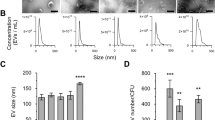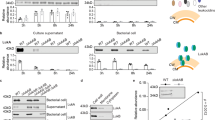Abstract
The excretion of cytoplasmic proteins (ECP) is a long-known phenomenon in bacteria and eukaryotes. So far, it was not possible to associate either a signal peptide-dependent or a signal peptide-independent pathway to ECP. Nevertheless 25 % of the proteins found in Staphylococcus aureus supernatants were cytoplasmic proteins. Because the excreted proteins do not possess a common motive, the most widespread opinion is that ECP is due to cell lysis. This explanation seems to be too easy since several indications imply that there exists a yet unknown mechanism for ECP. Certainly, the up-regulation of autolysins as well as decreased peptidoglycan cross-linking increased ECP. However, in recent years, several evidences arose that cell lysis is not the only reason for ECP. It seems that ECP is a part of the normal cell cycle of S. aureus as it turned out that ECP with several model proteins occurs mainly during cell growth. It has common features as proteins secreted via the Sec translocon and finally the excretion site is the cross wall of dividing cells.

Similar content being viewed by others
Abbreviations
- Atl:
-
Mayor autolysin
- CPs:
-
Cytoplasmic proteins
- ECP:
-
Excretion of cytoplasmic proteins
- FbaA:
-
Aldolase
- GAPDH:
-
Glyceraldehyde-3-phosphate dehydrogenase
- Eno:
-
Enolase
- LysM-L1,2 :
-
Lysin-rich cell wall binding motif
References
Berks BC, Palmer T, Sargent F (2005) Protein targeting by the bacterial twin-arginine translocation (Tat) pathway. Curr Opin Microbiol 8:174–181
Biswas R, Voggu L, Simon UK, Hentschel P, Thumm G, Götz F (2006) Activity of the major staphylococcal autolysin Atl. FEMS Microbiol Lett 259:260–268. doi:10.1111/j.1574-6968.2006.00281.x
Biswas L, Biswas R, Nerz C, Ohlsen K, Schlag M, Schäfer T, Lamkemeyer T, Ziebandt AK, Hantke K, Rosenstein R, Götz F (2009) Role of the twin-arginine translocation pathway in Staphylococcus. J Bacteriol 191:5921–5929. doi:10.1128/JB.00642-09
Boel G, Pichereau V, Mijakovic I, Maze A, Poncet S, Gillet S, Giard JC, Hartke A, Auffray Y, Deutscher J (2004) Is 2-phosphoglycerate-dependent automodification of bacterial enolases implicated in their export? J Mol Biol 337:485–496. doi:10.1016/j.jmb.2003.12.082
Bogsch EG, Sargent F, Stanley NR, Berks BC, Robinson C, Palmer T (1998) An essential component of a novel bacterial protein export system with homologues in plastids and mitochondria. J Biol Chem 273:18003–18006
Burts ML, Williams WA, DeBord K, Missiakas DM (2005) EsxA and EsxB are secreted by an ESAT-6-like system that is required for the pathogenesis of Staphylococcus aureus infections. Proc Natl Acad Sci 102:1169–1174. doi:10.1073/pnas.0405620102
Driessen AJ, Nouwen N (2008) Protein translocation across the bacterial cytoplasmic membrane. Annu Rev Biochem 77:643–667. doi:10.1146/annurev.biochem.77.061606.160747
Ebner P, Prax M, Nega M, Koch I, Dube L, Yu W, Rinker J, Popella P, Flötenmeyer M, Götz F (2015) Excretion of cytoplasmic proteins (ECP) in Staphylococcus aureus. Mol Microbiol. doi:10.1111/mmi.13065
Giesbrecht P, Kersten T, Maidhof H, Wecke J (1998) Staphylococcal cell wall: morphogenesis and fatal variations in the presence of penicillin. Microbiol Mol Biol Rev 62:1371–1414
Götz F, Yu W, Dube L, Prax M, Ebner P (2015) Excretion of cytosolic proteins (ECP) in bacteria. Int J Med Microbiol 305(2):230–237. doi:10.1016/j.ijmm.2014.12.021
Henderson B, Martin A (2013) Bacterial moonlighting proteins and bacterial virulence. Curr Top Microbiol Immunol 358:155–213. doi:10.1007/82_2011_188
Herbert S, Ziebandt AK, Ohlsen K, Schafer T, Hecker M, Albrecht D, Novick R, Götz F (2010) Repair of global regulators in Staphylococcus aureus 8325 and comparative analysis with other clinical isolates. Infect Immun 78:2877–2889. doi:10.1128/IAI.00088-10
Hirose I, Sano K, Shioda I, Kumano M, Nakamura K, Yamane K (2000) Proteome analysis of Bacillus subtilis extracellular proteins: a two-dimensional protein electrophoretic study. Microbiology 146:65–75
Jeffery CJ (1999) Moonlighting proteins. Trends Biochem Sci 24:8–11
Kusch H, Engelmann S (2014) Secrets of the secretome in Staphylococcus aureus. Int J Med Microbiol 304:133–141. doi:10.1016/j.ijmm.2013.11.005
Li M, Rosenshine I, Tung SL, Wang XH, Friedberg D, Hew CL, Leung KY (2004) Comparative proteomic analysis of extracellular proteins of enterohemorrhagic and enteropathogenic Escherichia coli strains and their ihf and ler mutants. Appl Environ Microbiol 70:5274–5282. doi:10.1128/AEM.70.9.5274-5282.2004
Nega M, Dube L, Kull M, Ziebandt AK, Ebner P, Albrecht D, Krismer B, Rosenstein R, Hecker M, Götz F (2015) Secretome analysis revealed adaptive and non-adaptive responses of the Staphylococcus carnosus femB mutant. Proteomics 15:1268–1279. doi:10.1002/pmic.201400343
Novick R (1967) Properties of a cryptic high-frequency transducing phage in Staphylococcus aureus. Virology 33:155–166
Pancholi V, Fischetti VA (1992) A major surface protein on group A streptococci is a glyceraldehyde-3-phosphate-dehydrogenase with multiple binding activity. J Exp Med 176:415–426
Pancholi V, Fischetti VA (1993) Glyceraldehyde-3-phosphate dehydrogenase on the surface of group A streptococci is also an ADP-ribosylating enzyme. Proc Natl Acad Sci USA 90:8154–8158
Pancholi V, Fischetti VA (1998) alpha-enolase, a novel strong plasmin(ogen) binding protein on the surface of pathogenic streptococci. J Biol Chem 273:14503–14515
Pasztor L (2011) Untersuchung der Signalpeptidunabhängigen Translokationswege in Staphylococcus aureus microbial genetics. University Tübingen, Thesis, p 198
Pasztor L, Ziebandt AK, Nega M, Schlag M, Haase S, Franz-Wachtel M, Madlung J, Nordheim A, Heinrichs DE, Götz F (2010) Staphylococcal major autolysin (atl) is involved in excretion of cytoplasmic proteins. J Biol Chem 285:36794–36803. doi:10.1074/jbc.M110.167312
Ranjit DK, Endres JL, Bayles KW (2011) Staphylococcus aureus CidA and LrgA proteins exhibit holin-like properties. J Bacteriol 193:2468–2476. doi:10.1128/JB.01545-10
Rice KC, Bayles KW (2003) Death’s toolbox: examining the molecular components of bacterial programmed cell death. Mol Microbiol 50:729–738
Schlag M, Biswas R, Krismer B, Köhler T, Zoll S, Yu W, Schwarz H, Peschel A, Götz F (2010) Role of staphylococcal wall teichoic acid in targeting the major autolysin Atl. Mol microbiol 75:864–873. doi:10.1111/j.1365-2958.2009.07007.x
Sibbald MJ, Ziebandt AK, Engelmann S, Hecker M, de Jong A, Harmsen HJ, Raangs GC, Stokroos I, Arends JP, Dubois JY, van Dijl JM (2006) Mapping the pathways to staphylococcal pathogenesis by comparative secretomics. Microbiol Mol Biol Rev 70:755–788. doi:10.1128/MMBR.00008-06
Sibbald MJ, Winter T, van der Kooi-Pol MM, Buist G, Tsompanidou E, Bosma T, Schafer T, Ohlsen K, Hecker M, Antelmann H, Engelmann S, van Dijl JM (2010) Synthetic effects of secG and secY2 mutations on exoproteome biogenesis in Staphylococcus aureus. J Bacteriol 192:3788–3800. doi:10.1128/JB.01452-09
Tjalsma H, Antelmann H, Jongbloed JD, Braun PG, Darmon E, Dorenbos R, Dubois JY, Westers H, Zanen G, Quax WJ, Kuipers OP, Bron S, Hecker M, van Dijl JM (2004) Proteomics of protein secretion by Bacillus subtilis: separating the “secrets” of the secretome. Microbiol Mol Biol Rev 68:207–233. doi:10.1128/MMBR.68.2.207-233.2004
von Heijne G (1990) The signal peptide. J Membr Biol 115:195201
Wang G, Chen H, Xia Y, Cui J, Gu Z, Song Y, Chen YQ, Zhang H, Chen W (2013) How are the non-classically secreted bacterial proteins released into the extracellular milieu? Curr Microbiol 67:688–695. doi:10.1007/s00284-013-0422-6
Xia XX, Han MJ, Lee SY, Yoo JS (2008) Comparison of the extracellular proteomes of Escherichia coli B and K-12 strains during high cell density cultivation. Proteomics 8:2089–2103. doi:10.1002/pmic.200700826
Yang CK, Zhang XZ, Lu CD, Tai PC (2014) An internal hydrophobic helical domain of Bacillus subtilis enolase is essential but not sufficient as a non-cleavable signal for its secretion. Biochem Biophys Res Commun 446:901–905. doi:10.1016/j.bbrc.2014.03.032
Zhang L, Jacobsson K, Vasi J, Lindberg M, Frykberg L (1998) A second IgG-binding protein in Staphylococcus aureus. Microbiology 144(Pt 4):985–991
Ziebandt AK, Becher D, Ohlsen K, Hacker J, Hecker M, Engelmann S (2004) The influence of agr and sigmaB in growth phase dependent regulation of virulence factors in Staphylococcus aureus. Proteomics 4:3034–3047
Zoll S, Schlag M, Shkumatov AV, Rautenberg M, Svergun DI, Götz F, Stehle T (2012) Ligand-binding properties and conformational dynamics of autolysin repeat domains in staphylococcal cell wall recognition. J Bacteriol 194:3789–3802. doi:10.1128/JB.00331-12
Acknowledgments
We thank Daniela Eberhart and Sebastian Reichert for carefully reading the manuscript. This work was supported by the Deutsche Forschungsgemeinschaft: SFB766 to F.G.
Author information
Authors and Affiliations
Corresponding author
Additional information
Communicated by M. Kupiec.
Rights and permissions
About this article
Cite this article
Ebner, P., Rinker, J. & Götz, F. Excretion of cytoplasmic proteins in Staphylococcus is most likely not due to cell lysis. Curr Genet 62, 19–23 (2016). https://doi.org/10.1007/s00294-015-0504-z
Received:
Accepted:
Published:
Issue Date:
DOI: https://doi.org/10.1007/s00294-015-0504-z




